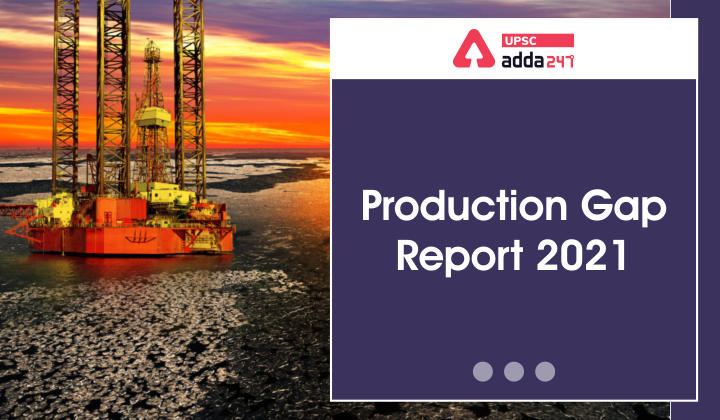Table of Contents
Production Gap Report 2021: Relevance
- GS3: Conservation, environmental pollution and degradation, environmental impact assessment.
Production Gap Report 2021: Context
- UNEP has recently released Production Gap Report 2021 to show discrepancy between governments’ planned fossil fuel production and global production levels consistent with limiting warming to 1.5°C or 2°C.
Production Gap Report 2021: Key points
- The report represents a collaboration of several researchers and academic institutions.
- The report was first launched in 2019 and this year was the third edition of the report.
- The report also tracks how governments worldwide are supporting fossil fuel production through their policies.
- The report also tracks how governments worldwide are supporting fossil fuel production through their policies.
Fossil fuel production gap report: Key findings
- The production gap has remained largely unchanged since the first analysis in 2019.
- The report finds that over the next two decades, governments across the world are collectively projecting an increase in global oil and gas production, and only a modest decrease in coal production.
- The report finds that given the government priorities and their effort towards fossil fuel production, total fossil fuel production will increase at least till 2040.
- The window to limit the long-term climate to 1.5°C is rapidly closing.
- The world’s governments plan to produce around 110% more fossil fuels in 2030 than would be consistent with limiting warming to 1.5°C, and 45% more than consistent with 2°C.
- Governments’ production plans and projections would lead to about 240% more coal, 57% more oil, and 71% more gas in 2030 than would be consistent with limiting global warming to 1.5°C.
- Global gas production is projected to increase the most between 2020 and 2040 based on governments’ plans. This continued, long-term global expansion in gas production is inconsistent with the Paris Agreement’s temperature limits.

Production gap report UNEP: COVID-19 recovery
The G20 countries has channelised $300 billion to fossil fuels since the beginning of the pandemic, and the sector is still enjoying significant fiscal incentives.
- Notably, capital flow towards fossil fuels is higher than to clean energy in the post COVID-19 recovery phase.
- The commitments at the UN COP26 would decide the fate of fossil fuel production across the world.
Status of Coral Reefs of the World Report
Production gap report 2021 India
- The report indicates that India has projected an increase in production of all the fossil fuels—coal, oil and natural gas.
- Notably, India has not set any commitment to achieve net-zero carbon emission.
| Fossil Fuel | Rank in Global Production | Share of Global Production |
| Coal | 5th | 7% |
| Oil | 24th | 1% |
| Natural Gas | 23rd | 1% |
State of Climate Services Report 2021


 TSPSC Group 1 Question Paper 2024, Downl...
TSPSC Group 1 Question Paper 2024, Downl...
 TSPSC Group 1 Answer key 2024 Out, Downl...
TSPSC Group 1 Answer key 2024 Out, Downl...
 Cabinet Ministers of India 2024, New Cab...
Cabinet Ministers of India 2024, New Cab...







